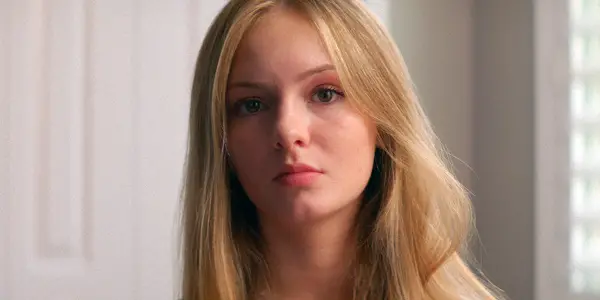Tribeca Film Festival 2023: TAKE CARE OF MAYA

Stephanie Archer is 39 year old film fanatic living in…
Back in 2015, the Connecticut State Supreme Court ruled that a 17-year-old resident would remain in the custody of the state child welfare system after avoiding a chemotherapy treatment that could save her life. The court had ruled that this 17-year-old was not mature enough to make decisions regarding her own body and the treatment of cancer that threatened her life. For Cassandra, the treatment of chemotherapy was not one that she was ready to undergo, her personal beliefs about what should be put in her body viewed the life-saving treatment as a poison. And while her parents supported their daughter’s decision, the state’s court system disagreed, retaining the custody of the child while she stayed at Hartford Hospital for treatment. The case flooded the local news, delivering a platform for the argument of bodily autonomy and the fundamental right to “common-law bodily integrity”. Was Cassandra right, less than a year of her 18th birthday, to make decisions about her own body? Were her parents right to support her? What’s more – did the state have the right to intervene?
I found myself thinking back to this case as I read the description of Henry Roosevelt‘s Take Care of Maya. Premiering at this year’s Tribeca Film Festival, the case of parents accused of medical abuse even in the face of their daughter’s medically diagnosed condition seems both horrifying and vital. And while these two cases are drastically different, there is the continuing debate of both patient and parental rights versus the concerns and intervention of state organizations. And while in Connecticut our child welfare system is still public, in Florida it is privatized.
The Diagnosis
Take Care of Maya works well to stage its three acts of the documentary. Opening on Maya’s father Jack Kowalski, the film begins to break down both Maya’s family and the onset of her diagnosis. In 2015, Maya began experiencing immense pain, her legs turning inward. Doctor after the doctor left Maya and her family with no answers, her illness became progressively worse. And while they would find answers in Dr. Kirkpatrick and his diagnosis of CRPS (Complex Regional Pain Syndrome), the extremes the family still needed to give relief to Maya still stood before them. The most effective treatment for CRPS is ketamine, and the required dosage varies from patient to patient. For the most severe of cases, a ketamine coma is required – and Maya was the most severe of cases.

The first third of the film works well to handle the medical terminology and emotional uncertainty surrounding Maya, her diagnosis, and the forms of treatment recommended. While the treatment feels extreme in it initial introduction, Take Care of Maya aids its audience well in both processing the use of the ketamine, as well as the dedication Maya’s parents have to make sure she improves. If you have read the synopsis prior to watching the film, you know the state’s involvement in Maya’s care is just around the corner, giving extra weight to each decision Maya’s parents and her doctor make in formulating and executing her treatment. It also hits harder when the inevitable arrives.
The Pieces Fall
In the midst of hope, the devastation of Take Care of Maya comes in like a storm, raging with an unrelenting force of will that seems impossible to escape. As Hurricane Matthew slams Flordia, Maya relapses, her parents taking her to the hospital. As they try to provide Maya’s medical history to the hospital staff, an alarm begins to rise at the Ketamine doses Maya has been taking and the diagnosis of CRPS as it is not a recognized diagnosis. In response, the hospital staff reaches out to social services. It is shocking how quickly Maya’s parents are taken from her, the documentary giving space for the Kowalskis to reveal the devastation it brought on the family.

As Take Care of Maya works through the legal struggles the Kowalski’s underwent in their attempt to get Maya back, the documentary works to broaden its scope beyond Maya, showing the fractures and failures of a system. It is as vital as it is heartbreaking as you watch a system set on guilt before even meeting the presumed guilty – and its determination to keep it that way. Take Care of Maya will truly drive the audience’s emotional investment deep in the second portion of the film, refusing to go easy on its viewers. From anger to frustration to tears, Take Care of Maya delivers a deeply affecting look at the breakdown of a family when another says it’s broken.
Fighting So Nothing Was In Vain
Take Care of Maya will break your heart. Just as you start questioning the participants missing in the film, the true gravity of the devastation of the Kowlaski family hits. And it hits hard. Yet, even in its darkest moments, Take Care of Maya works to end on the idea of hope. As Maya and her family work to bring justice to the treatment they received, they endure to help prevent the same treatment from happening to another family. While the legality of their lawsuit continually hits brick walls on the path for justice, it is their endurance that shines becoming the film’s brightest beacon of hope.
Take Care of Maya premiered at the 2023 Tribeca Film Festival on June 10, 2023. It will steam on Netflix on June 19, 2023!
Watch Take Care of Maya
Does content like this matter to you?
Become a Member and support film journalism. Unlock access to all of Film Inquiry`s great articles. Join a community of like-minded readers who are passionate about cinema - get access to our private members Network, give back to independent filmmakers, and more.













